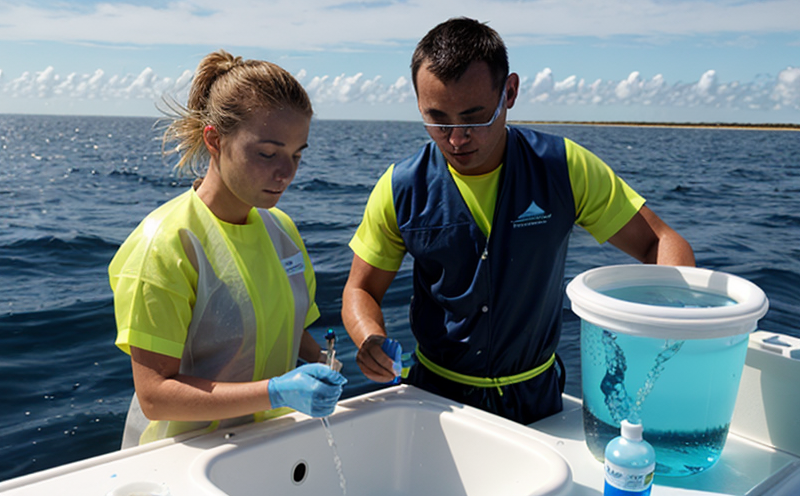ISO 9308-1 E Coli and Coliform Test in Seawater
The ISO 9308-1 standard is a pivotal guideline used globally to assess the presence of fecal coliforms, specifically E. coli, in seawater. This test is essential for ensuring that recreational waters meet public health standards and are safe for human contact. The methodology outlined in this international standard ensures accurate quantification through standardized sampling procedures and laboratory analysis.
The first step in conducting an ISO 9308-1 compliant test involves selecting appropriate samples from various locations within the seawater body being tested. Sampling must be done using sterile containers to avoid contamination, which can skew results. Once collected, these samples are transported back to the lab under controlled conditions, typically refrigerated at 4°C.
The actual testing process begins by diluting the seawater sample with a buffered peptone water solution to achieve appropriate concentrations suitable for detection using membrane filtration techniques. This step is critical as it helps in ensuring that there's an optimal count of organisms per milliliter, which enhances accuracy during subsequent steps.
Following dilution, membranes are inoculated with the diluted seawater and incubated at 36°C ± 1°C for approximately four hours. After this initial growth phase, colonies visible on the membrane are counted as either total coliforms or E. coli based on their appearance under microscopic examination.
This quantitative analysis provides a clear picture of the microbial load present in the seawater sample, thereby aiding decision-makers responsible for water quality management. By adhering to ISO 9308-1 guidelines, laboratories ensure that their findings are consistent with international standards, making them reliable and comparable across different regions.
The results from this testing procedure play a crucial role in determining whether the seawater meets regulatory limits set forth by organizations like WHO or EPA concerning acceptable levels of fecal indicator bacteria. Such information is vital for beach managers who need to inform the public about water safety conditions accurately.
In summary, implementing ISO 9308-1 ensures consistent and accurate measurement of E. coli and coliform bacteria in seawater samples. This approach not only enhances reliability but also contributes significantly towards maintaining public health standards by providing actionable insights derived from scientific testing methods.
Applied Standards
The ISO 9308-1 standard has been widely adopted worldwide due to its robustness and precision. It aligns with other international guidelines such as the United States Environmental Protection Agency's (EPA) Method 1600 series, which also focuses on detecting coliform bacteria in various water matrices including seawater.
The primary goal of these standards is to provide a harmonized approach to monitoring microbial quality parameters. Compliance with ISO 9308-1 guarantees that laboratories are using best practices recognized internationally, ensuring consistent and accurate results across diverse geographic locations.
Why Choose This Test
- Ensures compliance with international standards for water quality assessment.
- Provides reliable data on the presence of E. coli in seawater which is critical for public health protection.
- Supports decision-making processes regarding beach closures or advisories based on accurate microbial counts.
- Aids in identifying potential sources of contamination and tracking trends over time within specific coastal areas.
Use Cases and Application Examples
The ISO 9308-1 E. coli test finds application in multiple sectors including environmental monitoring, public health surveillance, and recreational water management. For instance:
- Environmental Monitoring: Regular testing helps identify changes in seawater quality due to natural or anthropogenic factors.
- Public Health Surveillance: Continuous monitoring allows for early detection of pathogens before they cause outbreaks among beachgoers.
- Recreational Water Management: Beach managers use these test results to inform the public about water safety conditions accurately.
In addition, this testing method is crucial during periods when there have been reports of gastrointestinal illnesses linked to exposure to contaminated seawater. By providing precise microbial load data, this test supports targeted intervention measures aimed at mitigating risks associated with such exposures.





